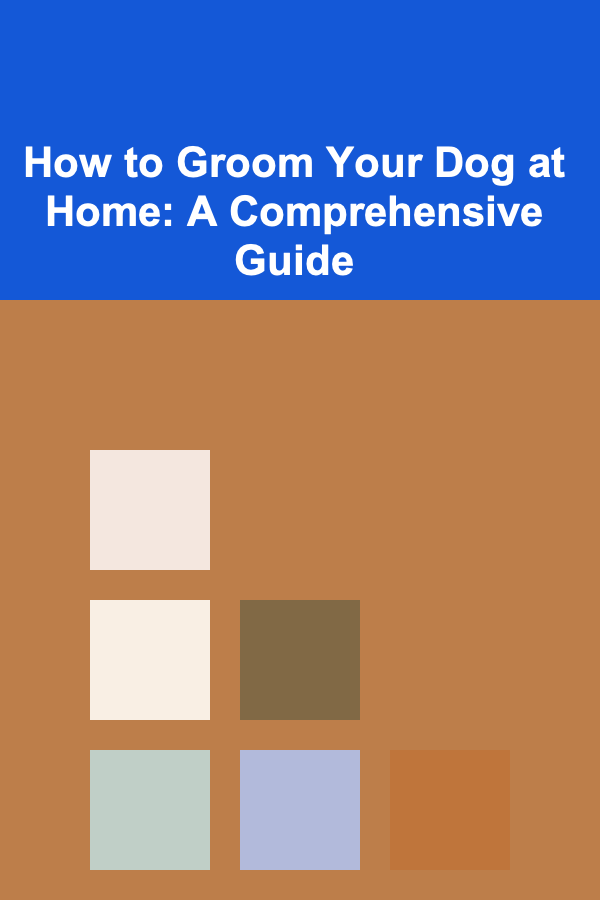
How to Groom Your Dog at Home: A Comprehensive Guide
ebook include PDF & Audio bundle (Micro Guide)
$12.99$10.99
Limited Time Offer! Order within the next:

Bringing a dog into your life is a joy, filled with endless cuddles, playful antics, and unwavering companionship. But responsible dog ownership extends beyond walks and belly rubs; it includes diligent grooming. While professional groomers offer valuable services, learning to groom your dog at home is a rewarding experience that strengthens your bond, saves money, and allows you to tailor your grooming routine to your dog's specific needs. This comprehensive guide will equip you with the knowledge and techniques to confidently groom your furry friend at home, covering everything from basic brushing to nail trimming and ear cleaning.
Understanding Your Dog's Grooming Needs
Before diving into the specifics, it's crucial to understand that grooming needs vary significantly depending on your dog's breed, coat type, and lifestyle. A short-haired Labrador Retriever will require a vastly different grooming routine than a long-haired Afghan Hound. Consider these factors:
- Breed: Different breeds have distinct coat types, growth rates, and shedding patterns. Research your dog's breed-specific grooming requirements.
- Coat Type: Common coat types include short, smooth, double, long, wiry, curly, and hairless. Each type requires specific brushes, shampoos, and grooming techniques.
- Age: Puppies and senior dogs may have sensitive skin and require gentler grooming approaches.
- Activity Level: Dogs who spend a lot of time outdoors may require more frequent bathing and attention to their paws.
- Health Conditions: Certain health conditions, such as allergies or skin infections, can affect grooming needs and require specialized products and techniques. Consult with your veterinarian if you suspect any underlying health issues.
Essential Grooming Tools and Supplies
Investing in the right tools will make the grooming process easier, more efficient, and more enjoyable for both you and your dog. Here's a list of essential grooming supplies:
- Brushes: The type of brush you need depends on your dog's coat. Common types include:
- Slicker Brush: Ideal for removing mats and tangles, especially in long-haired breeds.
- Pin Brush: Good for general brushing and detangling.
- Bristle Brush: Smooths the coat and removes loose hair.
- Undercoat Rake: Removes loose undercoat, preventing mats and reducing shedding.
- Rubber Brush or Grooming Mitt: Effective for short-haired breeds to remove loose hair and massage the skin.
- Combs: Useful for detangling and checking for fleas or ticks. A metal comb with varying tooth spacing is a versatile choice.
- Dog Shampoo: Choose a shampoo specifically formulated for dogs. Avoid human shampoos, as they can strip your dog's coat of its natural oils. Consider hypoallergenic options if your dog has sensitive skin.
- Dog Conditioner (Optional): Can help to detangle and moisturize the coat.
- Nail Clippers: Guillotine-style or scissor-style clippers are available. Choose the one you're most comfortable using. Alternatively, a nail grinder can be used.
- Styptic Powder: Essential for stopping bleeding if you accidentally cut the quick while trimming nails.
- Ear Cleaning Solution: Formulated to gently remove wax and debris from your dog's ears.
- Cotton Balls or Pads: For cleaning ears.
- Dog Toothbrush and Toothpaste: Use toothpaste specifically formulated for dogs. Never use human toothpaste.
- Towels: Several absorbent towels for drying your dog after a bath.
- Grooming Table (Optional): A grooming table can make it easier to reach your dog and prevent back strain.
- Hair Dryer (Optional): A dog-specific hair dryer is recommended, as human hair dryers can get too hot and damage your dog's skin. Use the cool or warm setting only.
- Treats: Positive reinforcement is key! Keep plenty of treats on hand to reward your dog for good behavior during grooming.
Tip: Introduce your dog to the grooming tools gradually. Let them sniff and explore the brushes, clippers, and other equipment before using them. Pair the introduction with treats and praise to create positive associations.
Step-by-Step Guide to Home Grooming
Now that you have the tools and knowledge, let's walk through the steps of a comprehensive home grooming session:
1. Brushing
Brushing is the foundation of any good grooming routine. Regular brushing helps to remove loose hair, prevent mats and tangles, distribute natural oils, and stimulate blood circulation.
- Choose the right brush: Select a brush that is appropriate for your dog's coat type.
- Start gradually: Begin with short brushing sessions and gradually increase the duration as your dog becomes more comfortable.
- Brush in the direction of hair growth: Use gentle, even strokes, avoiding pulling or tugging.
- Pay attention to problem areas: Focus on areas that are prone to matting, such as behind the ears, under the armpits, and around the tail.
- Remove mats and tangles carefully: Use a slicker brush or mat splitter to gently work through mats. If a mat is too large or difficult to remove, consider trimming it with scissors, being extremely careful not to cut your dog's skin. Professional groomers can also assist with removing difficult mats.
- Reward your dog: Offer treats and praise throughout the brushing session to reinforce positive behavior.
2. Bathing
Bathing helps to remove dirt, debris, and odors from your dog's coat. However, over-bathing can strip the coat of its natural oils, leading to dryness and irritation. As a general rule, bathe your dog only when necessary, typically every few weeks or months, depending on their breed and activity level.
- Gather your supplies: Have your shampoo, conditioner (if using), towels, and a non-slip mat ready.
- Brush your dog thoroughly: Before bathing, brush your dog to remove loose hair and mats.
- Wet your dog: Use lukewarm water to thoroughly wet your dog's coat. Avoid getting water in their ears.
- Apply shampoo: Dilute the shampoo according to the instructions on the bottle. Apply the shampoo to your dog's coat, starting at the neck and working your way down.
- Lather and massage: Gently lather the shampoo and massage it into your dog's coat, paying attention to areas that are prone to dirt and odors.
- Rinse thoroughly: Rinse your dog's coat thoroughly with lukewarm water until all traces of shampoo are gone. Residual shampoo can cause skin irritation.
- Apply conditioner (optional): If using conditioner, apply it according to the instructions on the bottle. Let it sit for a few minutes, then rinse thoroughly.
- Dry your dog: Use towels to remove excess water. You can also use a dog-specific hair dryer on a low or cool setting. Be sure to dry your dog completely, especially in the winter months, to prevent them from getting cold.
Tip: Place a cotton ball in each of your dog's ears before bathing to help prevent water from entering.
3. Nail Trimming
Regular nail trimming is essential for your dog's comfort and health. Overgrown nails can cause pain, difficulty walking, and even injury. Aim to trim your dog's nails every 2-4 weeks, or as needed.
- Gather your supplies: Have your nail clippers, styptic powder, and treats ready.
- Get your dog comfortable: Start by gently handling your dog's paws and nails. Reward them with treats for allowing you to touch their paws.
- Identify the quick: The quick is the pink area of the nail that contains blood vessels and nerves. Avoid cutting into the quick, as it will cause pain and bleeding. If your dog has dark nails, it can be difficult to see the quick. Trim small amounts at a time until you see a small black dot in the center of the cut nail -- this indicates you're close to the quick.
- Trim the nails: Using your nail clippers, trim the tips of the nails, following the natural curve of the nail. Avoid cutting straight across, as this can cause the nails to split.
- Apply styptic powder if needed: If you accidentally cut the quick, apply styptic powder to stop the bleeding.
- Reward your dog: Offer treats and praise after each nail is trimmed.
Alternative: Nail Grinder If you're uncomfortable using nail clippers, consider using a nail grinder. A nail grinder allows you to slowly and gradually grind down the nails, reducing the risk of cutting the quick. It takes practice and patience, and you'll need to acclimate your dog to the sound and vibration of the grinder. Start with short sessions and gradually increase the duration as your dog becomes more comfortable.
4. Ear Cleaning
Regular ear cleaning helps to prevent ear infections and keep your dog's ears healthy. The frequency of ear cleaning depends on your dog's breed and lifestyle. Dogs with floppy ears or those who swim frequently may require more frequent ear cleaning.
- Gather your supplies: Have your ear cleaning solution, cotton balls or pads, and treats ready.
- Inspect your dog's ears: Look for signs of redness, inflammation, discharge, or odor. If you notice any of these signs, consult with your veterinarian.
- Apply ear cleaning solution: Gently lift your dog's ear flap and squirt a small amount of ear cleaning solution into the ear canal.
- Massage the base of the ear: Gently massage the base of the ear for 30-60 seconds to help loosen wax and debris.
- Allow your dog to shake their head: Let your dog shake their head to dislodge any remaining debris.
- Wipe the ear canal: Use a cotton ball or pad to gently wipe the ear canal, removing any visible wax or debris. Avoid inserting the cotton ball too deeply into the ear canal.
- Reward your dog: Offer treats and praise after each ear is cleaned.
5. Dental Care
Dental care is an often-overlooked aspect of dog grooming, but it's crucial for their overall health. Poor dental hygiene can lead to periodontal disease, which can cause pain, tooth loss, and even systemic health problems. Ideally, you should brush your dog's teeth daily, but even brushing a few times a week can make a significant difference.
- Gather your supplies: Have your dog toothbrush, dog toothpaste, and treats ready. Never use human toothpaste on a dog!
- Introduce the toothbrush and toothpaste gradually: Let your dog lick a small amount of toothpaste off your finger. Then, gently introduce the toothbrush and allow your dog to lick the toothpaste from the brush.
- Brush your dog's teeth: Gently lift your dog's lip and brush their teeth using small, circular motions. Focus on the outer surfaces of the teeth, where plaque and tartar tend to accumulate.
- Reward your dog: Offer treats and praise after brushing their teeth.
Alternatives: If your dog resists toothbrushing, consider using dental chews, enzymatic toothpastes that don't require brushing, or dental wipes. Consult with your veterinarian for recommendations.
6. Anal Gland Expression (Generally Not Recommended for Home Grooming)
Anal glands are small sacs located on either side of the anus that contain a foul-smelling fluid. These glands are normally emptied when your dog defecates. However, in some cases, the glands can become impacted and require manual expression. This procedure is generally not recommended for home grooming, as it can be uncomfortable and even painful for your dog if not done correctly. It's best left to a veterinarian or professional groomer. Signs of impacted anal glands include scooting, licking the anal area excessively, and a foul odor.
Addressing Specific Grooming Challenges
Despite your best efforts, you may encounter some common grooming challenges. Here's how to address them:
- Matting: Prevent matting by brushing your dog regularly, especially if they have long or thick fur. If mats do form, try to gently work them out with a slicker brush or mat splitter. If the mat is too large or difficult to remove, trim it with scissors or seek professional grooming assistance.
- Shedding: Shedding is a natural process for most dogs, but excessive shedding can be frustrating. To minimize shedding, brush your dog regularly with an undercoat rake to remove loose hair. You can also try adding a fish oil supplement to their diet to improve coat health.
- Fear of Grooming: Some dogs are naturally fearful of grooming. To help your dog overcome their fear, start slowly and gradually introduce them to the grooming tools and procedures. Use positive reinforcement, such as treats and praise, to create positive associations. If your dog is severely fearful, consider seeking professional help from a certified dog trainer or behaviorist.
- Skin Sensitivity: If your dog has sensitive skin, use hypoallergenic shampoo and avoid harsh chemicals. Rinse thoroughly after bathing to remove all traces of shampoo. You can also try adding a small amount of oatmeal to their bathwater to soothe irritated skin. If your dog's skin problems persist, consult with your veterinarian.
Maintaining a Positive Grooming Experience
The key to successful home grooming is to create a positive and stress-free experience for your dog. Here are some tips:
- Start Early: Introduce grooming to your dog as early as possible in their lives. Puppies are more adaptable and likely to accept grooming as a normal part of their routine.
- Be Patient: Grooming takes time and patience. Don't rush the process. If your dog becomes stressed or uncomfortable, take a break and try again later.
- Use Positive Reinforcement: Reward your dog with treats, praise, and affection throughout the grooming session.
- Make it a Routine: Establish a regular grooming schedule and stick to it as much as possible. This will help your dog become accustomed to the process and reduce anxiety.
- End on a Positive Note: Always end the grooming session on a positive note, even if you only manage to do a small amount of grooming. This will help your dog associate grooming with positive experiences.
When to Seek Professional Help
While home grooming can be a rewarding experience, there are times when it's best to seek professional help. Consider contacting a professional groomer if:
- Your dog has severe matting or tangles that you can't safely remove at home.
- Your dog is extremely fearful or aggressive during grooming.
- Your dog has underlying health conditions that make grooming difficult or dangerous.
- You are uncomfortable performing certain grooming procedures, such as anal gland expression.
- You simply don't have the time or energy to groom your dog yourself.
Conclusion
Grooming your dog at home is a rewarding experience that strengthens your bond and helps to keep your furry friend healthy and happy. By understanding your dog's specific needs, investing in the right tools, and following the step-by-step guide outlined in this article, you can confidently groom your dog at home and enjoy the benefits of a well-groomed and healthy companion. Remember to be patient, use positive reinforcement, and consult with a veterinarian or professional groomer if you encounter any challenges. Happy grooming!

How to Decorate Your Home on a Small Budget
Read More
How to Design a Pet-Friendly Living Room
Read More
How To Repair a Broken Window Blind
Read More
How to Store Extra Seating Options Without Cluttering
Read More
The Art of Supply Chain Optimization: A Practical Guide
Read More
How To Practice Self-Love for Better Relationships
Read MoreOther Products

How to Decorate Your Home on a Small Budget
Read More
How to Design a Pet-Friendly Living Room
Read More
How To Repair a Broken Window Blind
Read More
How to Store Extra Seating Options Without Cluttering
Read More
The Art of Supply Chain Optimization: A Practical Guide
Read More